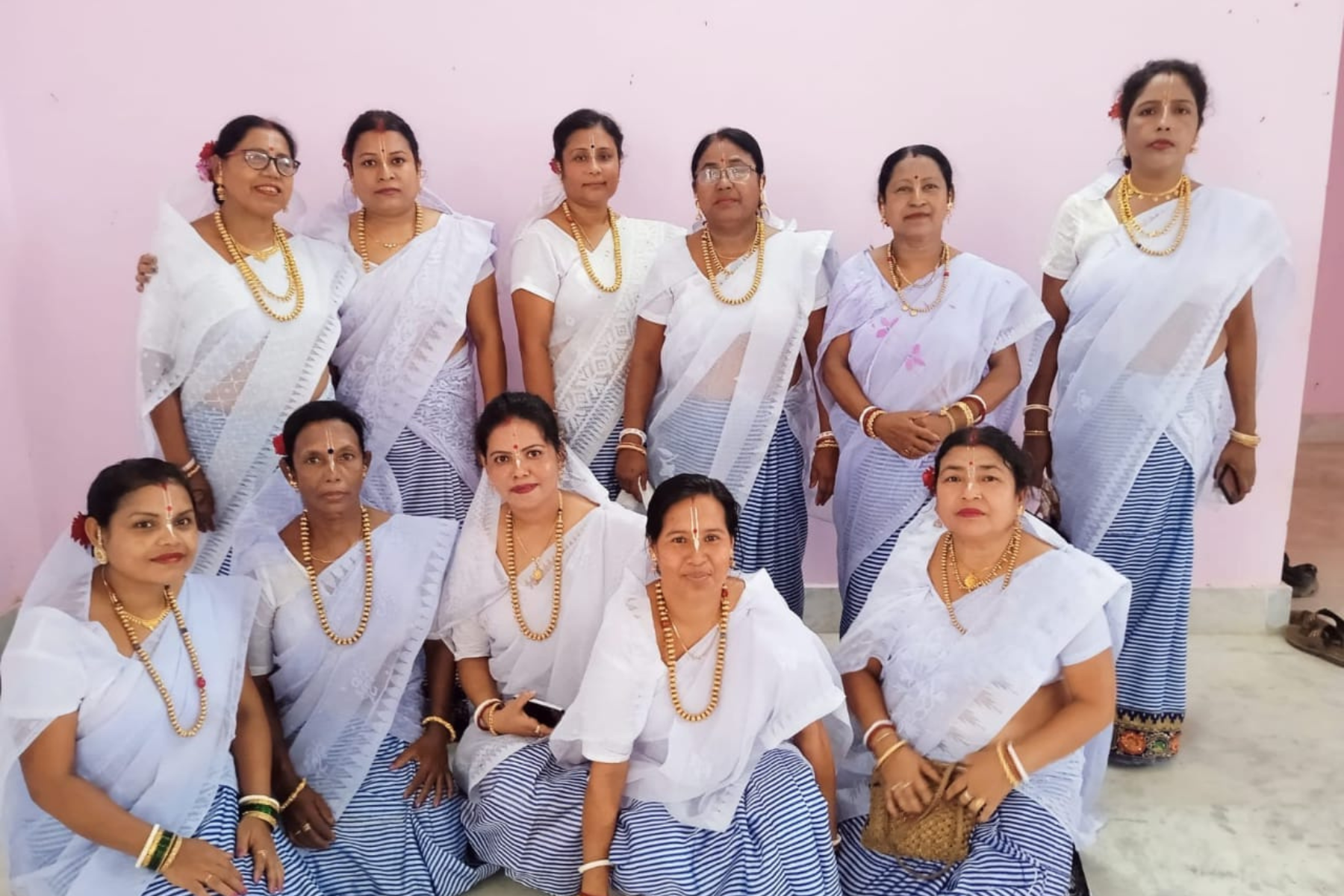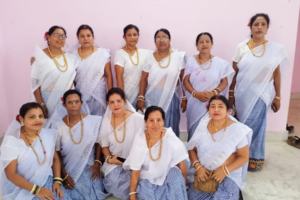“You can imagine how bad the situation is. People break into sobs when they get food to eat,” said social worker Monica Agarwal. “We receive several phone calls. When we tell them that we are coming with ration, they cry over the phone. These are the people who could not have ever imagined seeing such days,” she added.
Monica works for the rights of nomadic people, but presently she is working to provide ration to migrant labourers, who have been stranded during the lockdown in Gurgaon, in the National Capital Region. She has been associated with the Gurgaon Nagrik Ekta Manch, a civil society group, and many people associated with the forum are helping the labourers trapped in the lockdown by forming separate teams. Monica is a member of one such delivery team. She receives a list of labourers requiring help every day. According to the list, she sets out with three or four vans carrying 100 kits of ration.
Monica said: “According to this list, we have to provide ration to the labourers. Although we keep one or two kits extra, wherever we go, there is a huge crowd of people. Then many have to be refused saying that it isn’t for them, but for somebody else. This upsets us as we go there to help the labourers. But, sadly, this happens to us every day.”
She added: “We tell them that we will come later. When we try to get their mobile number, most of them don’t know their numbers. They hand over their phones to us. As a precautionary measure, we avoid touching their mobiles. When we say take down our number, they don’t know how to save a mobile number. It gets really complicated at times.”
Since the first day of the lockdown, the Gurgaon Nagrik Ekta Manch that Monica is working with, is supplying cooked food to 32,900 workers in Gurgaon every day. More than 15,000 ration kits have been distributed to the labourers, so far, through this platform. This number continues to increase.
Talking about the condition of the labourers during the second lockdown, Monica said: “There was silence in the first week of the lockdown, but during the second lockdown, there was an increase in the number of people asking for ration. We had difficulty in ascertaining who needed the ration more and many times, the one actually requiring ration had to go without it.”
She added: “Sometimes, a labourer would accidentally get the ration twice, which he would sell later on and buy milk for the children or refill gas cylinder. After all, they had many more problems. In the third lockdown, the situation has become even worse.”
Since 27 March, the Gurgaon @NagrikEkta Manch has provided rations to more than 13,000 households and distributed some 6 lakh cooked meals.
— Amitabh Dubey (@dubeyamitabh) May 2, 2020
Dozens of volunteers have helped deliver rations. Join us, or support the effort with donations. pic.twitter.com/FxxJmh85VD
It was not easy to reach out to labourers stranded in the lockdown. About 125 people associated with the Gurgaon Nagrik Ekta Manch are still active at different levels to find and help them. One of them is Rahul Roy.
Rahul said: “Towards the beginning of the lockdown, we had distributed only 500 ration kits among workers, but soon we realized that it was not enough. The information on the labourers was not able to reach us directly so we approached the trade unions and many NGOs. We joined with them on the WhatsApp group and tried to reach out to more labourers through them.”
He added: “Gradually, we started receiving calls seeking help. Then we faced another big problem. For instance, we would receive a call from a labourer who would only mention about his problem. But when we would reach there to hand him over the ration, we would also come across a large number of labourers who were stranded too. To deal with this, we first formed a separate team for information and verification.”
We are now providing 30,000 meals a day. This would not have been possible without consistent efforts of all our supporters and partners.
— Gurgaon Nagrik Ekta Manch (@NagrikEkta) April 22, 2020
Pls keep the support coming. In addition to this we have also been providing relief kits.
To help us help more, please contribute. #Covid_19 pic.twitter.com/WyXfztgEQ0
Every evening, the team prepares a list, having details of labourers seeking help. In addition, there was a need for a large quantity of ration collection and preparation of ration kits. For this, a warehouse was built in Gurgaon’s Udyog Vihar and Sector-38, where the packaging team’s job was to call for ration from the wholesaler and prepare the kits. Based on the list, teams are dispatched at 11 AM and 4 PM.
There came a time when these people associated with the Gurgaon Nagrik Ekta Manch had needed big budgets to provide ration to the labourers. For this, they appealed to people to help the labourers financially through the crowd-funding websites. This method worked and a large number of people came forward to help.
Meanwhile, the number of labourers seeking help was also increasing rapidly. Many labourers were found to have no cooking arrangements or had emptied gas cylinders and had no money to fill the cylinder. Those labourers needed to be provided with cooked food.
Rahul said: “With people’s support, we started our first kitchen on April 4 at Shri Ram School in Gurgaon to provide cooked food to the labourers. On the first day, we cooked food for 5,000 people. Today we are preparing daily meals for 12,000 people.”
He added: “In spite of this, a newer and bigger batch of labourers was coming up every day, so along with the labourers on our list, there was a growing demand for cooked food. We opened two more kitchens at Mallkheda village and Guru Nanak Girls School, where food is being prepared for 10,000-12,000 people every day. Our kitchen team of about 25 people is cooking daily for 32,900 people.”
In such a way, people associated with Gurgaon Nagrik Ekta Manch continue to help a large number of labourers every day in the third phase of the lockdown as well. However, their help is still falling inadequate. New labourers continue to be discovered every day.
Monica said: “There are many labourers who are not able to call for help, so we access that area through volunteers and search for labourers in need. As Manesar is a large industrial area in Gurgaon, here I was surveying the Bhangarula locality that has several big companies, including Maruti, where more than two lakh labourers work.”
“We were told that even if half of the workers have left for their homes, there are about one lakh workers stranded here. So, we are scouring the village to know about those workers. But then how much can we actually accomplish?” asked Monica.
She added: “There are several such villages where several thousand labourers are still trapped. Many live as tenants while some are living in tin shacks and slums. There are many migrants who are not accounted for so it is quite difficult to trace them. Now we are beginning to fear as to how they would survive these next two weeks.”
Even in the third phase of the lockdown, a large part of the labourers are still trapped and are deprived of any government help. It is still a big challenge to reach them. These labourers belonging to factories and the construction sector are still struggling for ration and food. They face starvation in the lockdown.
GNEM has been working hard to provide relief to daily wage labourers in Gurgaon at this time of crises. You can help us too. In case you would like to volunteer, or have information where relief is needed, pls DM us. You can contribute here https://t.co/ZMPs8o1fIt#COVID2019india
— Gurgaon Nagrik Ekta Manch (@NagrikEkta) April 17, 2020
Rahul said: “We are still looking out for labourers. They are found in the interiors, in narrow lanes and cramped quarters where it is difficult for us to deliver ration, so we try to deliver food in large utensils through carts, e-rickshaws, motorcycles to large utensils.”
He added: “When we arrive in such areas, they ask us for our mobile numbers so they may get food for the next day and call us for ration and food. Now, our personal mobile numbers have become helpline numbers for these labourers. We know that if we do not reach that area the next day, those people would have to go hungry.”
Ajay Kumar Mandal, a labourer working in a garment factory, remains trapped in Gurgaon with his wife and two children. Ajay is a resident of Kolachausa village in Madhepura district of Bihar and had returned to Gurgaon 15 days before the lockdown. So far, he has received ration thrice from the Gurgaon Nagrik Ekta Manch.
He said: “We are suffering a lot. Had we not got ration from them, hunger would have killed us before corona. It has difficult to even arrange for medicines for my children.”
When inquired if he wanted something from the government, Ajay said: “Now we simply want to be allowed to go home. We’d work there, but never come here again.”



















